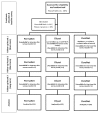A cluster randomized controlled cross-over bed net acceptability and preference trial in Solomon Islands: community participation in shaping policy for malaria elimination
- PMID: 20015402
- PMCID: PMC2803192
- DOI: 10.1186/1475-2875-8-298
A cluster randomized controlled cross-over bed net acceptability and preference trial in Solomon Islands: community participation in shaping policy for malaria elimination
Abstract
Background: A key component of the malaria elimination strategy in Solomon Islands (SI) is widespread coverage of long-lasting insecticidal nets (LLINs). The success of this strategy is dependent on LLIN acceptability and compliance. There has been unresolved debate among policy makers and donors as to which type of LLIN would be most appropriate for large-scale distribution in SI, and anecdotal reports of a lack of acceptability of certain brands of LLINs. A cluster randomized controlled crossover bed net acceptability and preference trial was therefore carried out from July to September, 2008 to inform policy and to facilitate community engagement and participation in the selection of the most appropriate LLIN for use in SI.
Method: A three-stage sampling method was used to randomly select the study population from Malaita Province, SI. Three brands of LLINs were assessed in this study: Olyset, PermaNet and DuraNet. Bed net acceptability and preference were evaluated through surveys at three defined time points after short and longer-term trial of each LLIN.
Results: The acceptability of PermaNet after short-term use (96.5%) was significantly greater than Olyset (67.3%, p < 0.001) and DuraNet (69.8%, p < 0.001). The acceptability of DuraNet and Olyset after short-term use was not significantly different at the 5% level. LLINs that were perceived not to prevent mosquito bites were significantly less acceptable than LLINs that were perceived to prevent mosquito bites (OR 0.15; 95%CI 0.03 to 0.6). LLINs that allow a pleasant night's sleep (OR 6.3; 95%CI:3.3-12.3) and have a soft texture (OR 5.7; 95%CI:1.9-20.5) were considered more acceptable than those that did not. Olyset's acceptability decreased over time and this was due to net wrinkling/shrinkage after washing resulting in reduced efficiency in preventing mosquito bites. The increase in DuraNet acceptability was a result of a reduction in minor adverse events following longer-term use.
Conclusion: This research was conducted to inform LLIN procurement as part of the national malaria control and elimination programme in SI. The success of malaria elimination in the Pacific and elsewhere relies on provision of acceptable interventions, consideration of local-level realities and engagement of communities in strategy development.
Trial registrations: Clinical trials ACTRN12608000322336.
Figures






Similar articles
-
Traditional nets interfere with the uptake of long-lasting insecticidal nets in the Peruvian Amazon: the relevance of net preference for achieving high coverage and use.PLoS One. 2013;8(1):e50294. doi: 10.1371/journal.pone.0050294. Epub 2013 Jan 2. PLoS One. 2013. PMID: 23300943 Free PMC article.
-
A qualitative study on the acceptability and preference of three types of long-lasting insecticide-treated bed nets in Solomon Islands: implications for malaria elimination.Malar J. 2009 Jun 4;8:119. doi: 10.1186/1475-2875-8-119. Malar J. 2009. PMID: 19497127 Free PMC article.
-
Evaluation of Interceptor long-lasting insecticidal nets in eight communities in Liberia.Malar J. 2010 Mar 24;9:84. doi: 10.1186/1475-2875-9-84. Malar J. 2010. PMID: 20334677 Free PMC article. Clinical Trial.
-
Evaluation of long lasting insecticidal nets in experimental huts and WHO PQT/VCP compliance: A systematic review.PLoS One. 2025 Mar 12;20(3):e0318673. doi: 10.1371/journal.pone.0318673. eCollection 2025. PLoS One. 2025. PMID: 40073043 Free PMC article.
-
Reported reasons for not using a mosquito net when one is available: a review of the published literature.Malar J. 2011 Apr 11;10:83. doi: 10.1186/1475-2875-10-83. Malar J. 2011. PMID: 21477376 Free PMC article. Review.
Cited by
-
Traditional nets interfere with the uptake of long-lasting insecticidal nets in the Peruvian Amazon: the relevance of net preference for achieving high coverage and use.PLoS One. 2013;8(1):e50294. doi: 10.1371/journal.pone.0050294. Epub 2013 Jan 2. PLoS One. 2013. PMID: 23300943 Free PMC article.
-
Bio-efficacy and wash resistance of MAGNet long-lasting insecticidal net against wild populations of Anopheles funestus in experimental huts in Muheza, Tanzania.Malar J. 2019 Oct 1;18(1):335. doi: 10.1186/s12936-019-2973-x. Malar J. 2019. PMID: 31570107 Free PMC article.
-
Experiences with insecticide-treated curtains: a qualitative study in Iquitos, Peru.BMC Public Health. 2016 Jul 16;16:582. doi: 10.1186/s12889-016-3191-x. BMC Public Health. 2016. PMID: 27422403 Free PMC article. Clinical Trial.
-
Possession and usage of insecticidal bed nets among the people of Uganda: is BRAC Uganda Health Programme pursuing a pro-poor path?PLoS One. 2010 Sep 10;5(9):e12660. doi: 10.1371/journal.pone.0012660. PLoS One. 2010. PMID: 20844749 Free PMC article.
-
Exploring provider and community responses to the new malaria diagnostic and treatment regime in Solomon Islands.Malar J. 2011 Jan 10;10:3. doi: 10.1186/1475-2875-10-3. Malar J. 2011. PMID: 21219614 Free PMC article.
References
-
- Chen WI. Malaria eradication in Taiwan, 1952-1964--some memorable facts. Gaoxiong Yi Xue Ke Xue Za Zhi. 1991;7:263–270. - PubMed
-
- Espino F, Koops V, Manderson L. Social, Economic and Behavioural Research Special Topics. TDR/STR/SEB/ST/04.1. Geneva: Special Programme for Research & Training in Tropical Diseases (TDR); 2004. Community participation and tropical disease control in resource-poor settings; pp. 1–48.
Publication types
MeSH terms
LinkOut - more resources
Full Text Sources
Medical

